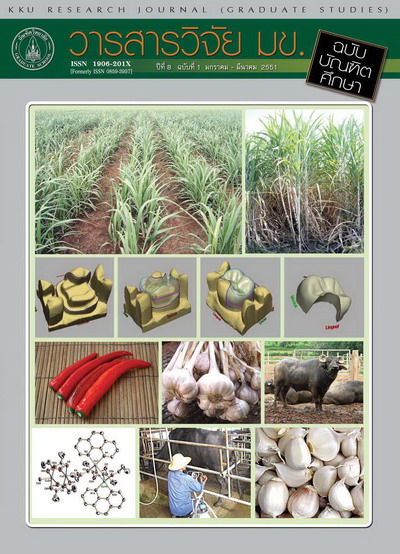A Study of Metacognition in Mathematical Problem Solving Through Studentsû Expository Writing(การศึกษาความตระหนักในการคิดในระหว่างการแก้ปัญหาทางคณิตศาสตร์จากการเขียนอธิบายของนักเรียน)
Keywords:
Metacognition(ความตระหนักในความคิด), Metacognition in mathematcal problem solving(ความตระหนักในการคิดในระหว่างการแก้ปัญหาทางคณิตศาสตร์), Expository writing(การเขียนอธิบาย)Abstract
การศึกษาครั้งนี้มีวัตถุประสงค์เพื่อวิเคราะห์องค์ประกอบของความตระหนักในการคิดในระหว่างการแก้ปัญหาทางคณิตศาสตร์จากการเขียนอธิบายของนักเรียน โดยใช้ระเบียบวิธีวิจัยเชิงคุณภาพแบบกรณีศึกษา ทำการวิเคราะห์ข้อมูลโดยการวิเคราะห์โปรโตคอล (Protocol Analysis) และบรรยายเชิงวิเคราะห์ (Analytic Description) กลุ่มเป้าหมายเป็นนักเรียน ชั้นมัธยมศึกษาปีที่ 1 ปีการศึกษา 2549 โรงเรียนคูคำพิทยาสรรพ์ กิ่งอำเภอซำสูง จังหวัดขอนแก่น จำนวน 6 คน (3 คู่) ร่วมมือกันทำกิจกรรมการแก้ปัญหาปลายเปิดคู่ละ 5 สถานการณ์ ในบริบทนอกชั้นเรียน ทีละคู่ ทีละสถานการณ์ปัญหา ไม่มีการแทรกแซงระหว่างการทำการแก้ปัญหา ทำการบันทึกวีดิทัศน์ บันทึกเทปเสียงและบันทึกภาคสนามเกี่ยวกับพฤติกรรมการแก้ปัญหาของกลุ่มเป้าหมายตลอดการแก้ปัญหาทั้ง 5 สถานการณ์ปัญหา ทำการวิเคราะห์ข้อมูลตามกรอบการวิเคราะห์ความตระหนักในการคิดของ Pugalee (2004) ที่ได้ปรับกรอบแนวคิดของ Garofalo & Lester (1985) ผลการวิจัย พบดังนี้ การเริ่มต้นกำหนดวิธีการแก้ปัญหา (Orientation) ได้แก่ 1) การอ่านปัญหา 2) การวิเคราะห์ข้อมูลและเงื่อนไขของปัญหา 3) การอธิบายในเริ่มแรกและเป็นลำดับ การวางแผนการแก้ปัญหา (Organization) ได้แก่ 1) การระบุเป้าหมายย่อยและเป้าหมายหลักของการแก้ปัญหา 2) การวางแผนรวมและกำหนดวิธีการเพื่อให้บรรลุเป้าหมาย 3) การเขียนไดอะแกรมและการจัดระบบข้อมูลที่ได้ในรูปแบบอื่นๆ การดำเนินการแก้ปัญหา (Execution) ได้แก่ 1) การดำเนินการตามแผนย่อย 2) การสำรวจตรวจตราความก้าวหน้าในการแก้ปัญหา การตรวจสอบ (Verification) ได้แก่ 1) การตรวจสอบการคำนวณในวิธีการแก้ปัญหาแต่ละวิธี โดยการคำนวณซ้ำ 2) การประเมินการตัดสินใจ นักเรียนพิจารณาความถูกต้องของวิธีการที่ใช้ในการแก้ปัญหาโดยการเปรียบเทียบคำตอบที่ได้จากการแก้ปัญหาในแต่ละวิธีThe target group consisted of six grade-7 students in Kookum Pittayasan School in Sumsoong Sub-District, Khon Kaen Province during the 2006 school year. They were subsequently organized into 3 pairs. Each pair of the students was asked to work together to solve 5 problems. The activity was organized outside the classroom without outside interference. While the students were working on the problems the researcher and her co-researchers made videotape and tape recording and took field notes of the activity. The obtained data were analyzed by means of Pugaleeûs (2004) metacognitive framework which was adapted from Garofalo and Lesterûs (1985) metacognitive framework. The findings: 1.At the orientation phase: Reading problem by the students read and reread provided problems, and (1) Analysis of information and conditions of those problems by considered and comprehend contents and information of those problems, and (2) Initial/subsequent representations by restating information from the problem before their organization or execution. 2.At the organization phase: (1) The students identified the goals and subgoals. (2) Making and implementing global plan by the students worked together to do planning, to actualize their goals. (3) Writing diagram and organizing that information to systems. 3. At the execution phase: (1) The students performed local goals by writing followed the planning. (2) Monitoring calculation progress by studied and looked through their proceeding as written and any new methods. 4. At the verification phase: (1) The students verified their calculations of each method by re-calculated. (2) Evaluating their decisions by the students consider the justice of the method that uses in solve problem by answer comparison that from in each the method.



